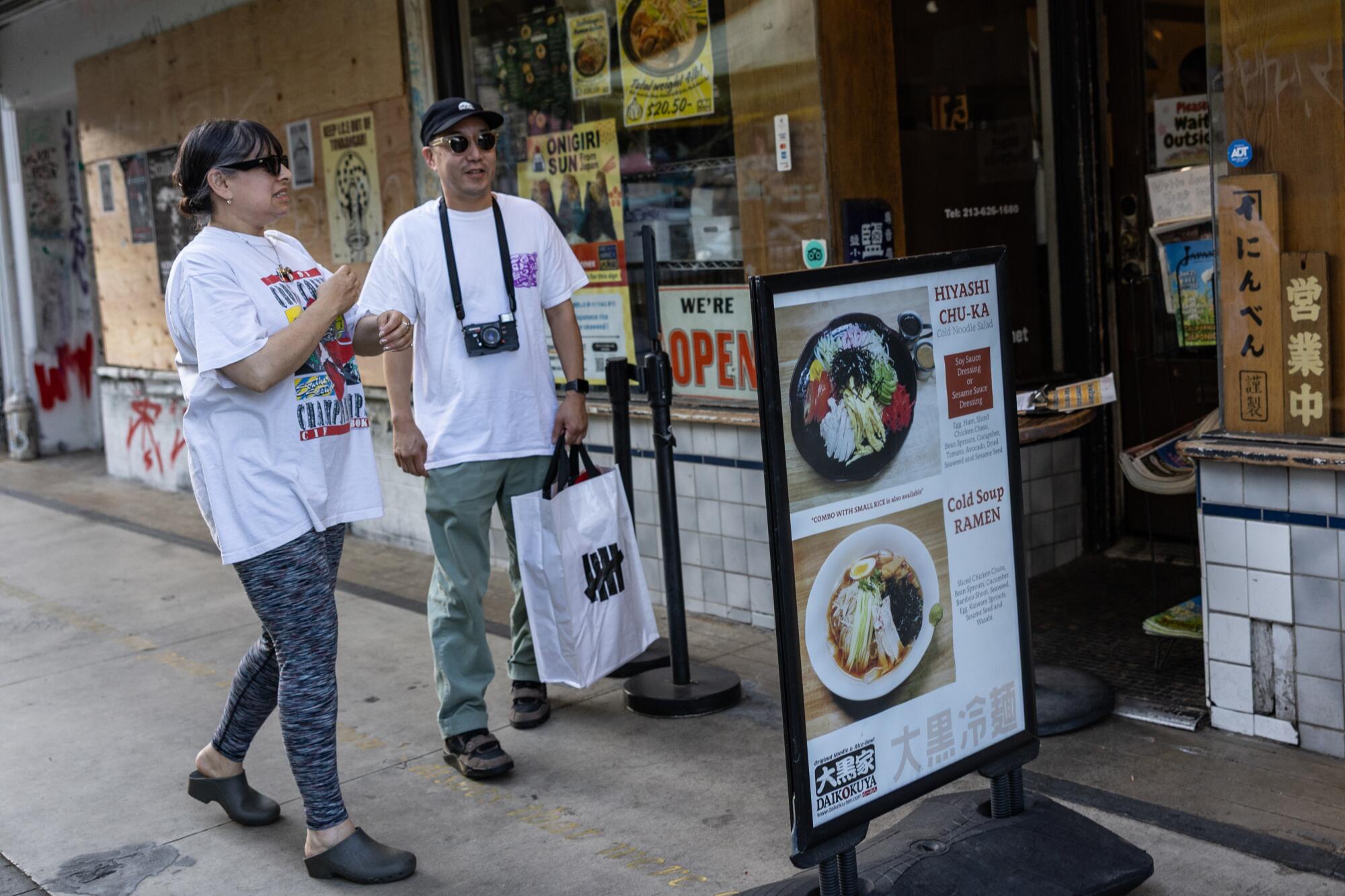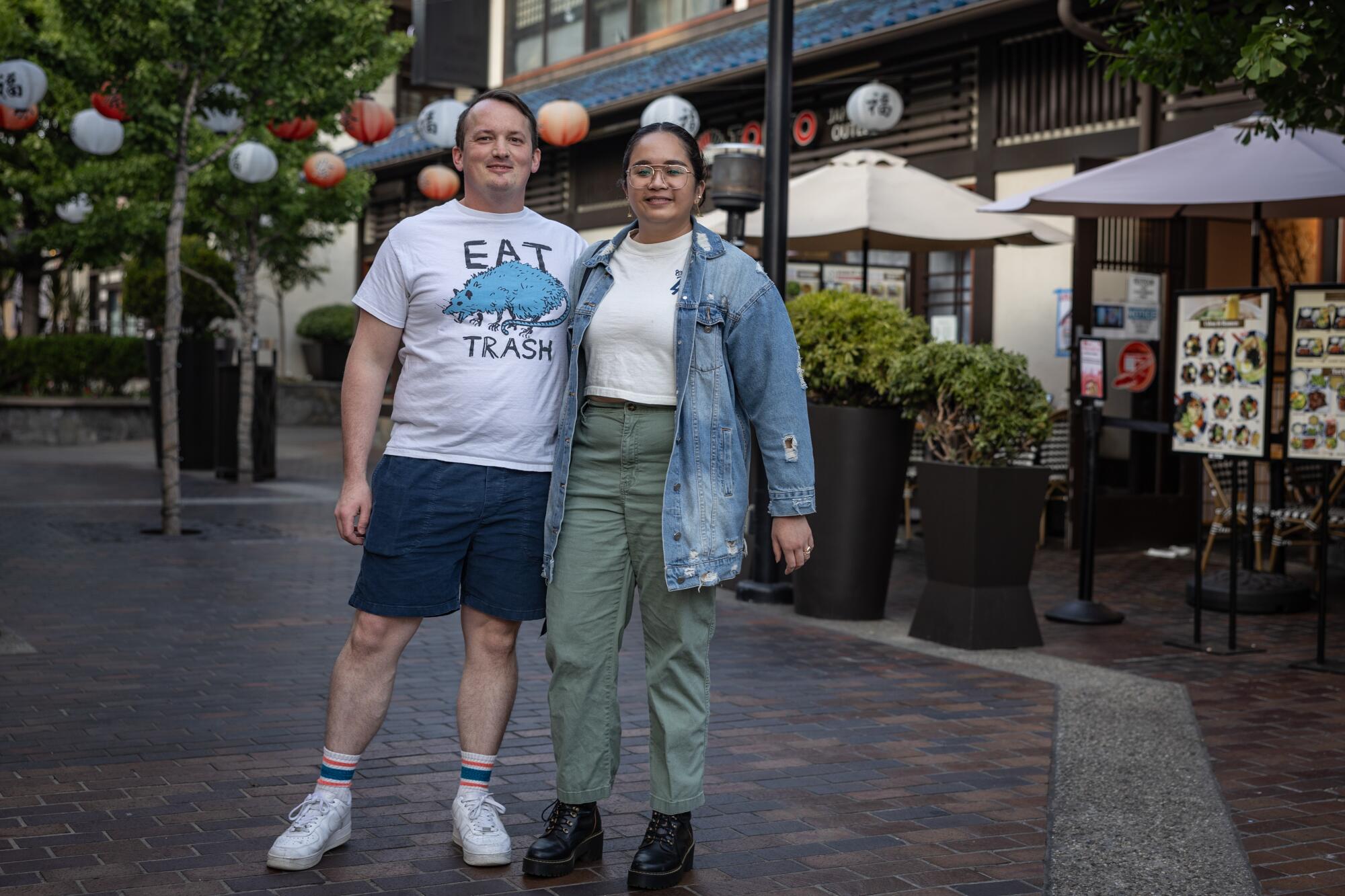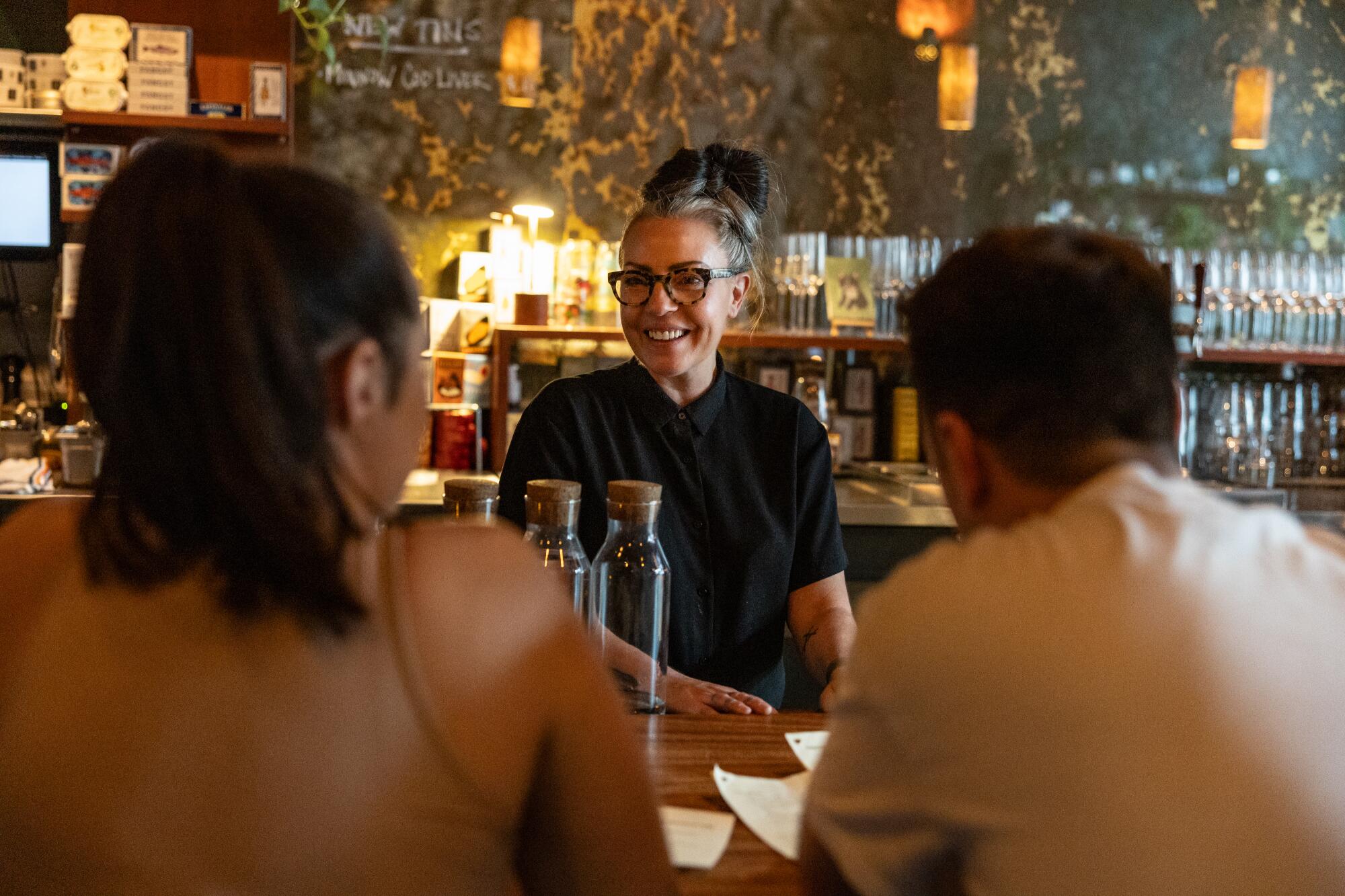It sounded just like the alarm for a extreme climate warning. At 8:19 p.m. on Monday night, my cellphone blared with a public security alert {that a} curfew was in place from 10 p.m. to six am. in downtown Los Angeles. It got here simply as I crested the hill on the south 110 Freeway that provides a sweeping view of the town under.
I used to be on my technique to meet a pal for dinner at Kinjiro, a cosy izakaya within the coronary heart of Little Tokyo.
The realm is without doubt one of the downtown neighborhoods most gravely affected by the aftermath of the current demonstrations protesting President Trump’s immigration insurance policies and the following raids.
Most of the storefronts in Little Tokyo had been boarded up in the course of the demonstrations that came about within the space following the ICE immigration raids.
(Jason Armond / Los Angeles Instances)
Mayor Karen Bass’ curfew, enacted every week prior in an effort to quell any chaos related to the demonstrations, meant the streets had been empty. It was the newest hurdle in an ever-expanding listing of challenges for Los Angeles eating places, which within the final 5 years have confronted drastic drops in enterprise from a pandemic, Hollywood writers’ strikes and fires.
All alongside 2nd Avenue, the home windows and doorways had been hidden behind plywood. Graffiti that includes alternative phrases for the police and Immigration and Customs Enforcement coated practically each floor.
The incessantly bustling Japanese Village Plaza, the place buyers dine at a revolving sushi bar and cease for cheese-filled corn canine, was desolate. Once I made it to the izakaya, it was clear that they had been closed. The home windows had been boarded up and a safety gate was pulled throughout the doorway.
We drove over to Bavel within the Arts District, curious to see if one of many metropolis’s most persistently booked eating places was feeling the results of the curfew, which coated the realm of downtown between the 5 and 10 freeways and from the ten to the place the 110 and 5 freeways merge.
You possibly can most likely measure the state of eating in Los Angeles by the fullness of the eating room at Ori Menashe and Genevieve Gergis’ Levant-leaning restaurant. A final-minute prime desk at 8 p.m. on some other night time? No probability. Once we arrived as walk-ins, we discovered a patio that was largely empty, sparse patrons on the bar and a eating room that felt devoid of the same old Bavel power. A fast scroll by means of the week’s upcoming reservations on OpenTable confirmed a number of openings every night time.
I drove house previous curfew, anticipating to see a checkpoint of types or perhaps even an elevated police presence. There wasn’t a single police automobile or protester. All of the streets had been open.
The 8 p.m. curfew, first issued on June 10, was modified to a ten p.m. curfew on Monday. On Tuesday, the curfew was lifted altogether, however many downtown eating places are nonetheless struggling to fill their eating rooms.

A portrait of chef Jon Yao of Kato restaurant. The Arts District restaurant noticed a big drop in reservations following the current curfew and demonstrations in downtown.
(Mariah Tauger / Los Angeles Instances)
Simply final week, Kato restaurant misplaced 80% of its reservations. Jon Yao, Ryan Bailey and Nikki Reginaldo’s Arts District tasting menu restaurant celebrates Yao’s upbringing within the San Gabriel Valley. It was named the No. 1 restaurant on the L.A. Instances 101 Record 3 times. Earlier this week, Yao received the James Beard Award for finest chef in California. If there’s a vacation spot restaurant in downtown Los Angeles, that is it.
On Tuesday, in gentle of the lifted curfew, the restaurant was nonetheless a 70% drop in reservations for the upcoming week.
“The direct impact of the media’s portrayal of DTLA being unsafe, which it is not, has impacted Kato immediately, and we were forced to close two nights,” Bailey says.
On Friday, round 20 of the reservations canceled had been for dinners booked weeks and months sooner or later.
“I had two specific instances where the guest called to say they were canceling their upcoming trip to L.A. based on not feeling safe in L.A. anymore,” Bailey says.

Kaminari Gyoza Bar posts “we are open” indicators to let guests know the enterprise is open in Little Tokyo. The realm was the epicenter of the current immigration protests.
(Jason Armond/Los Angeles Instances)
“The optimist in me hopes that the curfew, especially given the lifting now, does not cause long-term damage to downtown,” says Cassy Horton, co-founder of the DTLA Residents Assn. The group works to create a thriving city group in downtown that helps new and present residents within the space.
“This is why we have been advocating so strongly to make sure our small businesses can open up,” says Horton. “We need our neighbors across the region to really rally behind downtown right now because we need their support.”
Hours after the curfew was lifted Tuesday, downtown began to indicate indicators of coming to life once more.

Julia M. Leonard and Kevin Uyeda from Echo Park watch for a desk at Daikokuya in Little Tokyo.
(Jason Armond / Los Angeles Instances)
Simply earlier than 7 p.m., a line started to type at Daikokuya in Little Tokyo. The small ramen store is named a lot for the perpetual wait as it’s for its steaming bowls of tonkotsu ramen. It was a hopeful sight throughout every week of uncertainty, in an space that was the epicenter of the demonstrations.
“We checked with our friends who live right here and we were really mindful about coming tonight,” says Kevin Uyeda. He stood in line for ramen with fellow Echo Park resident Julie M. Leonard, each desirous to make the quick journey to Little Tokyo for dinner.
“I think there has been a lot of misinformation about the protests and the levels of everything,” says Leonard. “I don’t think the curfew was necessary. Most of the protests were peaceful.”

Diners get pleasure from a meal at Jincook Korean restaurant in Little Tokyo. The workers noticed double the variety of patrons after the current downtown curfew was lifted.
(Jason Armond / Los Angeles Instances)
A couple of doorways down, at Korean restaurant Jincook, the workers eliminated the boards masking the home windows that afternoon.
“It’s safe to come here,” says Jincook server Hendrik Su. “We want people to know that we are open.”
On the Japanese Village Plaza, strollers rolled by means of the winding walkway with patrons sipping boba. Arts District residents Renee Sogueco and Chris Ciszek carried luggage of leftovers from current stops at Daikokuya and Fugetsu-Do, the greater than a 100-year-old mochi and mango confectionery on 1st Avenue.
“Once we heard the curfew was lifted we wanted to come out,” says Sogueco. “We’ve been feeling really bad about it with all the immigrant-owned businesses being affected. Daikokuya was fairly busy, but not as busy as we’ve seen it.”

Arts District residents Chris Ciszek, left, and Renee Sogueco get pleasure from an evening out within the Japanese Village Plaza of Little Tokyo hours after the town’s curfew was lifted.
(Jason Armond / Los Angeles Instances)
Ciszek’s mother and father determined to make the journey out from Virginia to go to, regardless of associates again house questioning the choice.
“People are seeing a lot of very curated images online,” says Ciszek. “They don’t reflect what’s been happening downtown. From what we’ve seen, the protesters have been happy, dancing, playing music, not violently disruptive.”
I took a brief drive west to the South Broadway block that homes Grand Central Market and located individuals consuming tacos on the tables that line the sidewalk. A couple of locals sipped glasses of wine at close by Kippered, the wine and tinned fish bar from Lydia Clarke and Reed Herrick.
“With everything boarded up, it doesn’t feel inviting for tourists or people to come,” says Clarke. “We still need people from outside the neighborhood, so people don’t forget how great downtown is, how easy it is to come and pop around to a couple of places.”

Kippered co-owner Lydia Clarke chats with patrons at her tinned fish and wine bar in downtown Los Angeles. The neighborhood confirmed indicators of life after the town lifted a curfew meant to cease unrest following the continuing immigration raids.
(Jason Armond / Los Angeles Instances)
With the curfew being lifted, many eating places that closed, quickly opened for lunch or moved to thoroughly new places exterior of downtown Los Angeles, began to announce that they might return to common enterprise operations.
Lasita, the Filipino rotisserie and wine bar in Chinatown, reopened for dinner. Steve and Dina Samson’s Italian restaurant Rossoblu, which operated as a pop-up in Playa Vista over the weekend, returned to dinner service at its Trend District location just lately.
“I know we deal with so much in downtown, but when things get harder, our hearts get bigger,” says Clarke. “I’m feeling really hopeful again.”


